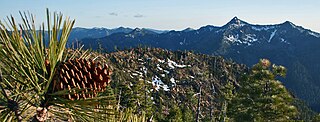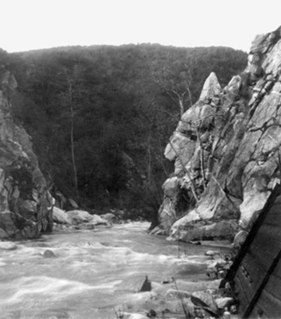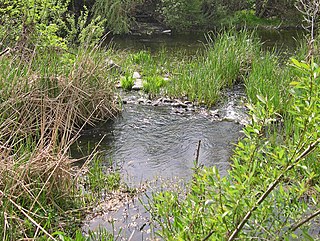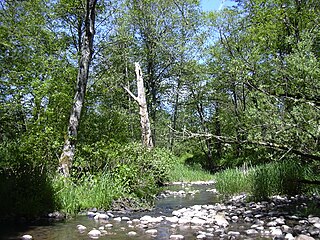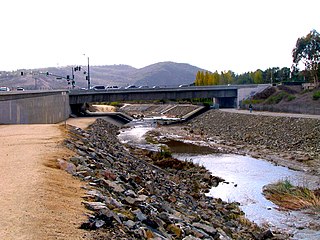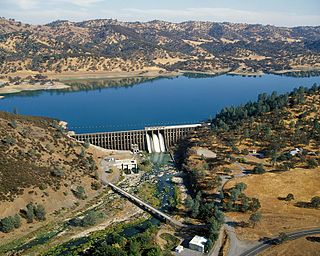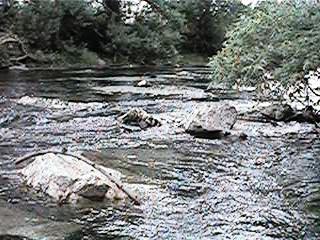| Blue Rock Springs Creek | |
|---|---|
| Country | United States |
| State | California |
| Region | Solano County |
| City | Vallejo |
| Physical characteristics | |
| Main source | Sulfur Springs Mountain 10 miles (16 km) east of Vallejo 400 ft (120 m) [1] 38°6′43″N122°11′4″W / 38.11194°N 122.18444°W [1] |
| River mouth | Rindler Creek Solano County Fairgrounds in Vallejo 85 ft (26 m) 38°7′51″N122°13′40″W / 38.13083°N 122.22778°W Coordinates: 38°7′51″N122°13′40″W / 38.13083°N 122.22778°W [1] |
Blue Rock Springs Creek is a 3.4-mile-long (5.5 km) [2] stream that rises on Sulfur Springs Mountain in southwestern Solano County, California. A bicycle trail is positioned along the creekside in some of the lower reaches. [3] Water quality is impaired in Blue Rock Springs Creek due to historic cinnabar extraction in this watershed. Blue Rock Springs Creek has been tested for the toxin diazinon and found to have attained an elevated value of 40.9 micrograms per liter; diazinon is a toxic pesticide associated with golf course maintenance. The 36-hole Blue Rock Springs Golf Course lies in this watershed; although diazinon has been banned for golf course use in the U.S., its persistence in the environment is quite high. The stream has had application of a hydrological transport model to analyze flooding potential and to aid in the design of certain stream channel modification carried out in the last quarter of the 20th century to accommodate urbanization of some of the lower reaches.

A stream is a body of water with surface water flowing within the bed and banks of a channel. The stream encompasses surface and groundwater fluxes that respond to geological, geomorphological, hydrological and biotic controls.

Solano County is a county located in the U.S. state of California. As of the 2010 census, the population was 413,344. The county seat is Fairfield.

Water quality refers to the chemical, physical, biological, and radiological characteristics of water. It is a measure of the condition of water relative to the requirements of one or more biotic species and or to any human need or purpose. It is most frequently used by reference to a set of standards against which compliance, generally achieved through treatment of the water, can be assessed. The most common standards used to assess water quality relate to health of ecosystems, safety of human contact, and drinking water.
Contents
Cinnabar deposits were extracted from this watershed in the early 1900s at Hastings Mine and St. John's Mine. [4] [5] Shaft construction occurred no earlier than 1918 and mining had ceased by the year 1930.
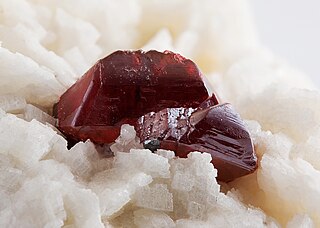
Cinnabar and cinnabarite, likely deriving from the Ancient Greek: κιννάβαρι (kinnabari), refer to the common bright scarlet to brick-red form of mercury(II) sulfide (HgS) that is the most common source ore for refining elemental mercury, and is the historic source for the brilliant red or scarlet pigment termed vermilion and associated red mercury pigments.
The Hastings Mine is a mineral extraction site approximately 4.5 miles (7.2 km) northeast of the city of Vallejo, Solano County, California. The Hastings site on Sulfur Springs Mountain was used for extraction of cinnabar until the year 1930. The Hastings Mine is classified as a medium priority mine from the standpoint of environmental oversight. In the last inspection of the Hastings Mine in 1997, sediments in a drainage below the mine were found to contain ten parts per million of mercury; furthermore, spring water below the mine exhibited a water concentration of .31 micrograms per liter. Miles of underground shafts were driven in the course of working the quicksilver deposits in the area. In 1989, Earth Metrics reviewed old 1918 maps of workings of the Hastings and St. John's Mines and found that mine shafts were not driven into the site prior to the year 1918.
The St John's Mine is a mineral extraction site approximately three miles north of the city of Vallejo in Solano County, California, United States. The St John's site was used for extraction of cinnabar in the early 1900s. The St. John's Mine is classified as a medium priority mine from the standpoint of environmental oversight. The last inspection of the Hastings Mine occurred in 1997 and found only slight erosion of the considerable mine tailings; however the tailings exceed 10,000 cubic yards (7,600 m3) of material, or one of the largest cinnabar tailings in the State of California. Furthermore, the drainage from St. John's Mine flows to receiving waters of Rindler Creek and thence to Lake Chabot. Miles of underground shafts were driven in the course of working the quicksilver deposits in the area. In 1989, Earth Metrics reviewed old 1918 maps of workings of the Hastings and St. John's Mines and found that mine shafts were not driven into the site prior to the year 1918.

